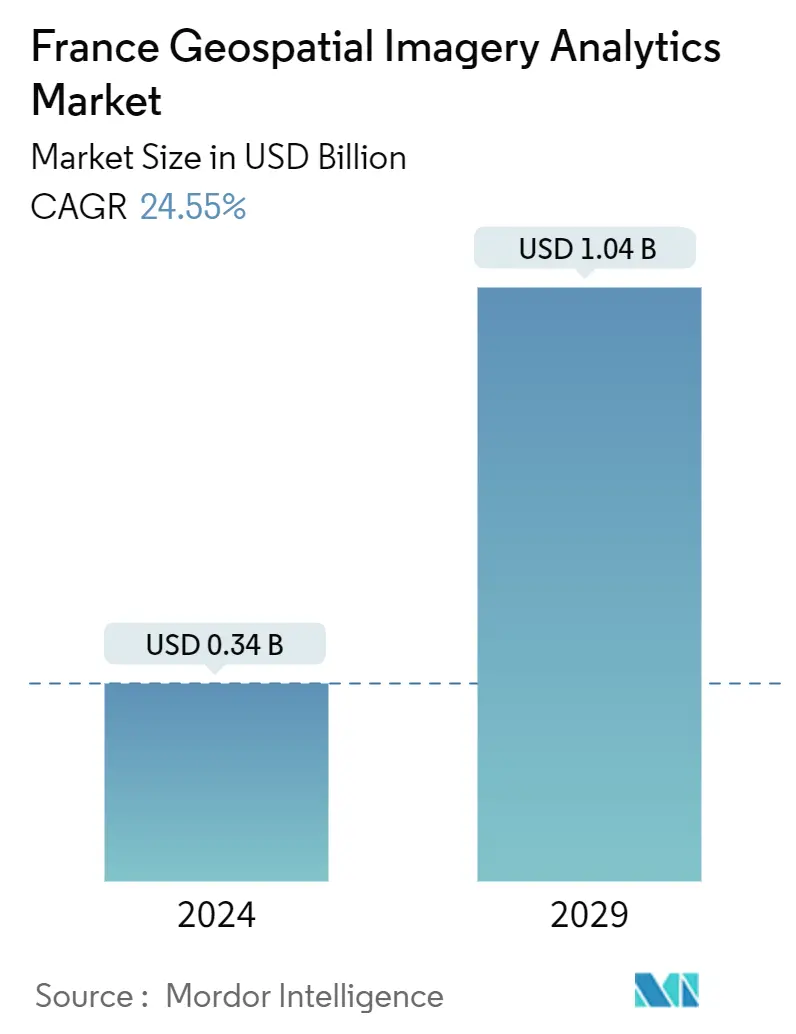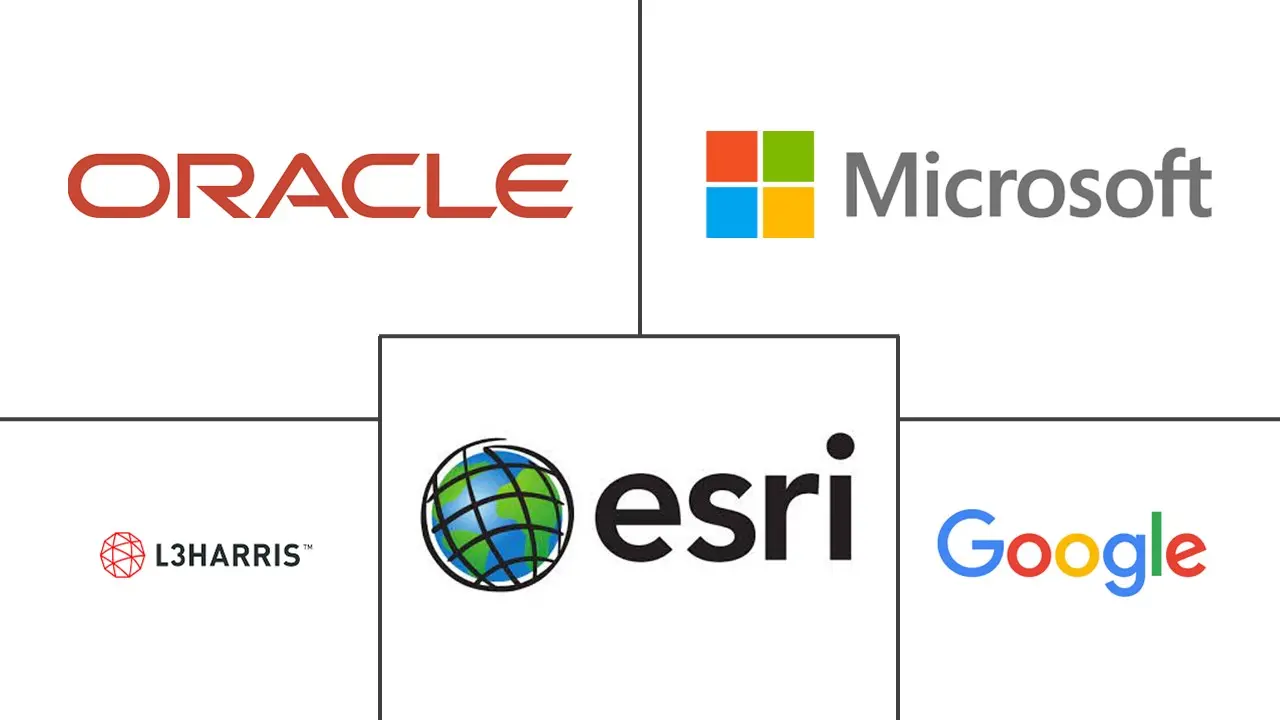Market Size of France Geospatial Imagery Analytics Industry

| Study Period | 2019-2029 |
| Base Year For Estimation | 2023 |
| Market Size (2024) | USD 0.34 Billion |
| Market Size (2029) | USD 1.04 Billion |
| CAGR (2024 - 2029) | 24.55 % |
| Market Concentration | Medium |
Major Players
*Disclaimer: Major Players sorted in no particular order |
France Geospatial Imagery Analytics Market Analysis
The France Geospatial Imagery Analytics Market size is estimated at USD 0.34 billion in 2024, and is expected to reach USD 1.04 billion by 2029, growing at a CAGR of 24.55% during the forecast period (2024-2029).
Geospatial imagery analysis refers to a broad range of activities that emphasize applying various techniques to data comprising geographical or space-related characteristics. Some of the key factors driving the growth of the geospatial imagery analytics market include the increasing technological advancements in the field of GIS technology, recent trends in integration and convergence of geospatial technologies, the advent of new business models aimed at leveraging the demand for geospatial information, and increased application of geospatial analytics in city and town planning.
The analysis of satellite or aerial photographs to generate significant information about the Earth's surface is done by geospatial imaging analytics. This technology is critical in many parts of mining operations, resulting in enhanced efficiency and safety. For instance, it allows mining companies to precisely assess mining conditions by offering a whole perspective of the location, which includes topography, terrain, vegetation cover, and infrastructure. Companies can improve safety and reduce accidents by analyzing this data, identifying possible dangers, and making proactive efforts to mitigate them.
Geospatial technology can provide extensive insights into a city's physical environment, infrastructure, and assets, allowing for more effective planning and decision-making. Higher frequencies, which are necessary for 5G networks, have a limited range and are prone to interference from various things. This data may be utilized to optimize the location of 5G infrastructure, resulting in higher network coverage and fewer signal disturbances. Several governments seeking to attract foreign direct investment have prioritized the development of 5G technology and infrastructure. Geospatial technology is critical in advancing these efforts, notably in developing smart cities.
For example, French climate and energy data analytics company Kayrros stated that it uses satellites to provide a spectral analysis, which can measure methane concentration in the atmosphere. Further, the data is analyzed using Kayrros proprietary algorithms to identify the emission events responsible for these methane plumes, examine leaks from gas pipes, and many more.
On the contrary, the legal and regulatory issues surrounding the usage of geospatial imaging analytics technologies are difficulties that stem from a variety of issues, including regional variations, location privacy concerns, intellectual property rights, data licensing, and geographical data storage. One of the key limits is the regional variation in data collection techniques. Geospatial imaging analytics is strongly reliant on current and reliable data, such as satellite images and aerial pictures. Access to such data, however, might be limited in particular locations or nations, making it difficult for geospatial technology suppliers to collect complete and consistent data for analysis.
Demand for geospatial analytics applications, such as those used in tourism and transportation, decreased due to COVID-19. The production facilities were also closed, which made it more challenging to supply and regulate electrical components. However, the pandemic increased the demand for public health applications, emergency response applications, and environmental monitoring applications, which in turn were used to track the spread of COVID-19 and identify areas at risk.
France Geospatial Imagery Analytics Industry Segmentation
Geospatial imagery analytics utilizes data collected from satellite images. The geo-referenced images are then delivered as raster and vector images. Raster images are individual pixels of color, also known as bitmaps. Vector images are graphics comprised of mathematical formulas and can be infinitely scaled. The france geospatial imagery analytics market is segmented by type,by deploymnet mode, by organization size and end user. By type, the market is segmented into imagery analytics and video analytics. By deploymenyt mode the market is segmented into on-premise and cloud. By organization size the market is segmented into SMEs and large enterprises. By verticals the market is segmented into insurance, agriculture, defense and security, environmental monitoring, engineering and construction, government and other verticals. The market sizes and forecasts are provided in terms of value in USD for all the above segments.
| By Type | |
| Imagery Analytics | |
| Video Analytics |
| By Deployment Mode | |
| On Premise | |
| Cloud |
| By Organization Size | |
| SMEs | |
| Large Enterprises |
| By Vericals | |
| Insurance | |
| Agriculture | |
| Defense and Security | |
| Environmental Monitoring | |
| Engineeting & Construction | |
| Government | |
| Others |
France Geospatial Imagery Analytics Market Size Summary
The France Geospatial Imagery Analytics Market is poised for significant growth, driven by advancements in GIS technology and the integration of geospatial technologies across various sectors. This market encompasses a wide range of activities that utilize geographical data to enhance decision-making and operational efficiency. The increasing application of geospatial analytics in urban planning, infrastructure development, and environmental monitoring is a key factor propelling market expansion. Additionally, the demand for geospatial imagery analytics in sectors such as mining, defense, and telecommunications underscores its critical role in improving safety, optimizing resource allocation, and enhancing network coverage. The development of smart cities and the push for 5G infrastructure further highlight the importance of geospatial technology in modern urban and rural planning.
Despite the promising growth trajectory, the market faces challenges related to legal and regulatory issues, such as data privacy concerns and regional variations in data collection. The COVID-19 pandemic has also impacted demand in certain applications while boosting interest in public health and emergency response analytics. Cloud-based solutions are gaining traction due to their cost-effectiveness and scalability, although security concerns remain a barrier to widespread adoption. The market is characterized by a semi-consolidated landscape with key players like Google, Microsoft, and ESRI actively engaging in strategic partnerships and product innovations. These developments, coupled with significant investments in space exploration and military expenditure, are expected to drive the demand for geospatial imagery analytics in France, positioning it as a pivotal player in the global market.
France Geospatial Imagery Analytics Market Market Size - Table of Contents
-
1. MARKET INSIGHTS
-
1.1 Market Overview
-
1.2 Industry Attractiveness - Porter's Five Forces Analysis
-
1.2.1 Bargaining Power of Buyers
-
1.2.2 Bargaining Power of Suppliers
-
1.2.3 Threat of New Entrants
-
1.2.4 Threat of Substitutes
-
1.2.5 Intensity of Competitive Rivalry
-
-
1.3 Industry Value Chain Analysis
-
1.4 Assessment of the Impact of COVID-19 on the Market
-
-
2. MARKET SEGMENTATION
-
2.1 By Type
-
2.1.1 Imagery Analytics
-
2.1.2 Video Analytics
-
-
2.2 By Deployment Mode
-
2.2.1 On Premise
-
2.2.2 Cloud
-
-
2.3 By Organization Size
-
2.3.1 SMEs
-
2.3.2 Large Enterprises
-
-
2.4 By Vericals
-
2.4.1 Insurance
-
2.4.2 Agriculture
-
2.4.3 Defense and Security
-
2.4.4 Environmental Monitoring
-
2.4.5 Engineeting & Construction
-
2.4.6 Government
-
2.4.7 Others
-
-
France Geospatial Imagery Analytics Market Market Size FAQs
How big is the France Geospatial Imagery Analytics Market?
The France Geospatial Imagery Analytics Market size is expected to reach USD 0.34 billion in 2024 and grow at a CAGR of 24.55% to reach USD 1.04 billion by 2029.
What is the current France Geospatial Imagery Analytics Market size?
In 2024, the France Geospatial Imagery Analytics Market size is expected to reach USD 0.34 billion.

